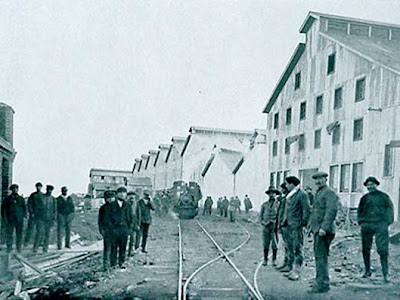 |
| In 1985, we rode this freight from San Antonio de los Cobres to the Chilean border at Socompa. |
That was in 1985, on the route now known as the Tren
a las Nubes (Train to the Clouds); to the best of my memory, it was the last time I rode a
long-distance train – as opposed to commuter and tourist trains - in Argentina
(or Chile,
for that matter). It was enormous fun, as the crew let us sleep in the caboose
and, during the daytime, the engineer even invited us up to the locomotive.
 |
| At one time, numerous train left from Retiro to destinations throughout Argentina. Today, only a handful do. |
Still, I’m often asked about trains in Argentina and,
reluctantly, I tell everybody that, unless you’re a fanatical trainspotter or perhaps even a foamer, it’s best to
stick to the bus or plane. In the 1980s we often took the train, most notably
on our honeymoon from Retiro (pictured above) to Mendoza,
a trip from hell that took place during Argentina’s July winter holidays of
1981. We were on a budget, in “Pullman” seats that reclined only slightly, and
our car filled up with military conscripts who, at that time, traveled for free
as long as they remained standing on a 24-hour marathon. It was not fun.
That no longer happens, partly because there is no more
conscription in Argentina but mostly because there are so few trains, and except
for the one that runs between Constitución
(Buenos
Aires, pictured above in early days) and Mar del
Plata, they’re pretty dismal. According
to the city daily Clarín, a rail network that stretched some 37,000 km in
1950 now covers only 7,500 km, and freight has priority on most of the
remaining track. Trains like El Gran Capitán, which until recently connected
the capital with the northern city of Posadas,
are by all accounts something to avoid (especially in summer, when the weather
is brutally hot and humid). It’s theoretically possible to travel by rail from
Constitución to Bariloche,
but that requires crossing the Río Negro from Carmen
de Patagones to Viedma
and then waiting six days for the connection.
Yet the trains are full, and that’s because they’re cheap.
To quote Clarín, “According to the level of service, the bus can cost nine
times more than the train,” which is the only option for many poorer
Argentines. The train to Córdoba,
for instance, costs 30 pesos (about US$7), while the bus can cost 250 pesos
(roughly US$64). For that reason, the trains sell out early: “In high season,
it’s better to buy 90 days ahead of time – the rest of the year 15 should be
sufficient – and departures are few: the train departs only Monday and Friday.”
That’s why I discourage anybody but the truly determined
from taking long-distance trains in Argentina. My friends Darek
Przebieda and Analía Rupar of Eureka Travel recommend the Tren Patagónico from
Viedma to Bariloche but, even then, they have to admit that the 18-hour trip
averages only about 45 km per hour, and a comfortable sleeper bus would cover the
distance in half the time. For my part, I’ll stick with an excursion on Esquel’s
La
Trochita.





















